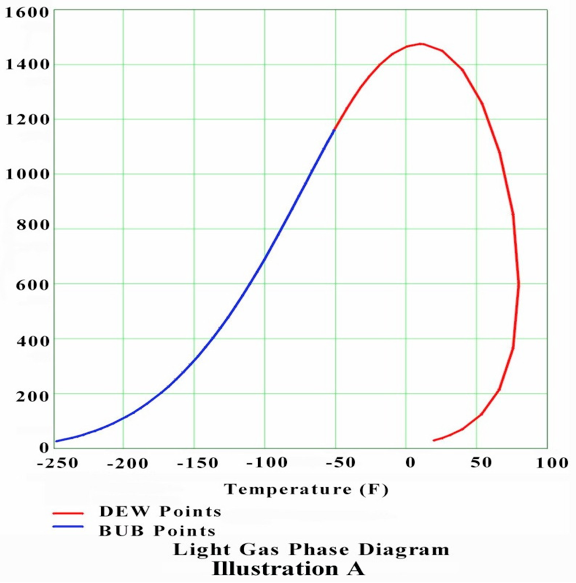In facilities operations the understanding of where the process is on a phase diagram can often help the engineer and operator avoid extremely embarrassing design and operating mistakes. The oil and gas industry is full of many “war stories” about “phase diagram disasters.” Most instances are never related back to the phase diagram misunderstanding. In one well-documented but poorly published case a “dry gas” pipeline that was pigged flooded miles of sandy beach. In another case thousands of kilowatts of compression power were installed to maintain the pressure of a reservoir above the dew point when in fact the reservoir was at a temperature above the cricondentherm. In many cases equipment manufacturers and purchasers of gas have specifications of “superheat” or dew point that have not been met and led to upset customers and/or millions of dollars of lawsuits.
One of the first issues to be resolved by a facilities engineer working in a gas plant or gas production facility is where is the process operating with respect to the phase diagram. A general knowledge, if not a detailed knowledge, will allow the design engineer and the facilities operator to make intelligent decisions that have significant impact on the profitability of a gas production facility.
The following figure is a “generic hydrocarbon mixture” phase diagram for a lean gas. The area to the left of the Bubble Point line is the sub-cooled liquid region.
 The area to the right of the Dew Point line is the super-heated gas region. Between these two lines the mixture is two-phase. Other areas of interest are the retrograde region and the supercritical region. Each of these regions provides advantages and disadvantages for operations.
The area to the right of the Dew Point line is the super-heated gas region. Between these two lines the mixture is two-phase. Other areas of interest are the retrograde region and the supercritical region. Each of these regions provides advantages and disadvantages for operations.
This month we will start to define the points of interest so that we may choose proper operating points for various types of processes. The first point to define is the cricondentherm. The definition of this point is the highest temperature at which two-phases (liquid and vapor for most processes) can coexist. In the drawing above this is point M. Point M has considerable theoretical and practical importance. For example, if the cricondentherm for a sales gas (point M) is 0 ºC (32 ºF) cooling the gas to 4 ºC (40 ºF) at any pressure will not result in condensation of liquids. This type of operation is typically the type used for cross-country transportation of gas in pipelines. Operation with this type of system will not require “slug catchers” at the end of the pipeline and will significantly decrease pressure drop in the pipeline.
If the gas were processed in a cold separator such that point B (a dew point) was 0 ºC (32 ºF) problems could occur in the same conditions as the pipeline mentioned above. If the pressure of the pipeline was between the pressure of point B and E and the pipeline cooled to 4 ºC (40 ºF) there could be significant quantities of liquid in the pipeline. If the operations people were not familiar with the phase diagram they might increase the operating pressure of the cold separator and still keep the temperature at 0 ºC (32 ºF). This action would result in increased liquids in the pipeline, not decreased. However, if the cold separator was operated at the pressure of point M, at a temperature of 0 ºC (32 ºF), in theory there would be no liquids in the pipeline again. (More about the difference between theory and practice in future tips).
If you want more information about how to use phase diagrams to improve profitability of operations or how to generate a phase diagram similar to the calculated drawing below, from a process simulator using equations of state, use our search engine above. You may look for a course to attend, books or software to buy or other articles on this web site.
Suggested search words: phase diagram, dew point control, equation of state, process simulation, gas conditioning and processing.
By: Dr. Larry L. Lilly


The Best air conditioning services in singapore in singapore.
[…] Lilly, L., “Why do I care about phase diagrams?”, PetroSkills June 2005 […]